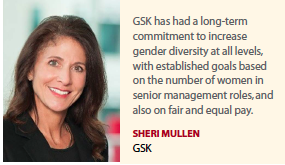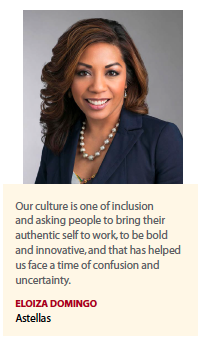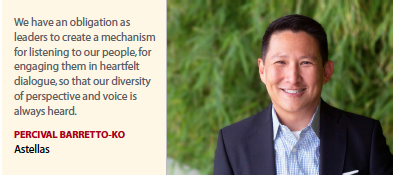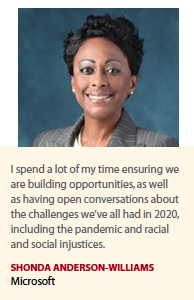As companies grapple with an emotional year in terms of the pandemic and racial inequality, efforts to address diversity and inclusion are gaining momentum.
When Joe Biden and Kamala Harris won the 2020 U.S. presidential election, it signaled a huge leap forward for diversity: the first woman Vice President of the United States, the first person of South Asian descent, and the first African-American woman to be elected to the office. Vice President-elect Harris smashed the glass ceiling for women everywhere.
 Diversity and inclusion measures have helped to move the needle across many industries, including healthcare. Yet the workplace, especially at senior levels, still has a long way to go. While healthcare is one of the most progressive industries when it comes to female representation, reports show that women —particularly women of color — remain underrepresented in leadership roles.
Diversity and inclusion measures have helped to move the needle across many industries, including healthcare. Yet the workplace, especially at senior levels, still has a long way to go. While healthcare is one of the most progressive industries when it comes to female representation, reports show that women —particularly women of color — remain underrepresented in leadership roles.
Increasingly, though, organizations recognize that diversity and inclusion are both a social imperative and a business advantage.
According to data compiled by Shonda Anderson-Williams, healthcare and life sciences digital transformation leader at Microsoft, diverse companies outperform the competition by 35%. Furthermore, millennials are looking for a more diverse and inclusive workplace with 62% saying they want a career with social impact and purpose, and as many as 72% saying they would leave an organization for a more inclusive one.
A diverse workplace can drive more innovation thanks to a greater diversity of beliefs, values, and motivations. Exclusion, on the other hand, hinders productiveness by reducing intelligent thought and reasoning, increasing self-defeating behavior, reducing pro-social behavior, impairing self-regulation, leading to increased defensiveness, and decreasing well-being.
 Many companies are taking progressive steps to address imbalances in diversity, equity, and inclusion. Information compiled by the Healthcare Businesswomen’s Association’s Gender Parity Collaborative, aka The Collaborative, which brings together senior executives from various industry organizations to discuss the necessary environmental and systemic changes needed to accelerate the pace of change and transform the industry in the process, reports that 56% of Collaborative companies have leadership teams comprised of more than 30% women and 100% of Collaborative member companies have been recognized by industry and/or trade media awards for diversity, women’s, and workplace efforts.
Many companies are taking progressive steps to address imbalances in diversity, equity, and inclusion. Information compiled by the Healthcare Businesswomen’s Association’s Gender Parity Collaborative, aka The Collaborative, which brings together senior executives from various industry organizations to discuss the necessary environmental and systemic changes needed to accelerate the pace of change and transform the industry in the process, reports that 56% of Collaborative companies have leadership teams comprised of more than 30% women and 100% of Collaborative member companies have been recognized by industry and/or trade media awards for diversity, women’s, and workplace efforts.
According to Marie-Caroline Strok, Gender Parity Collaborative, director, HBA, Collaborative companies show about a 12% improvement when measured against the industry overall. “We are focused on several areas, such as engaging men as allies in gender parity and diversity initiatives, addressing ethnic diversity, and tackling the issues that impact women of color," she says. Ms. Strok believes the HBA’s continuing efforts to dive deeper into the data and tackle the systemic issues that impact diversity, starting with hiring processes all the way through to identifying high-potential candidates for senior-level positions, will make a big difference.
She says, companies such as Pfizer, which was a founding member of The Collaborative, GSK, and BMS are referencing The Collaborative’s efforts in their annual reports. “This represents that these companies are putting a stake in the ground, which underscores the seriousness of addressing gender parity and diversity," she says. (For more information about The Collaborative, see the sidebar and visit www.hbanet.org.) Further, the HBA received the 2020 Power of A Summit award from the American Society of Association Executives (ASAE) for advancing systemic diversity, equity, and inclusion progress in the workplace.
ASAE’s Power of A Awards, the industry’s highest honor, which recognize the association community’s valuable contributions on the local, national, and global levels, reward outstanding accomplishments of associations and industry professionals who work tirelessly to solve problems and strengthen lives, the workforce, the economy, and the world.
A View of the Landscape
PharmaVOICE spoke with several leaders in the industry to find out what steps they and their companies are taking toward greater diversity, equity, and inclusion.
Percival Barretto-Ko, president of Astellas US, says the dual impact of the COVID-19 pandemic and the focused attention on issues of racial inequity and social injustice during 2020 have challenged the company to be actively compassionate and thoughtful in the face of tremendous adversity. “Our considerable long-term focus on employee diversity and cultural inclusion took on heightened strategic importance, not because it was popular, but because it was critical and the right thing to do," he says. “Specifically, we instituted a process of regular review of data and benchmarks among all U.S. divisions, identifying opportunities and reporting updates and progress to employees. We created a D&I governance council of top U.S. leadership to align on objectives and strategy, while encouraging open dialogue. We re-examined and redefined our health equity strategy, completing in the process an inventory of teams and initiatives focused on historically underserved communities.
“Finally, we launched a three-year people strategy, creating three employee-led teams to integrate best-in-class strategies to increase our ability to attract, develop and retain top and diverse talent across the Astellas network," he adds.
As global head of D&I at Astellas, Eloiza Domingo says the company’s formal commitment to D&I is relatively new, beginning efforts in this regard around 2016. She joined the company in November 2018 and the company has continued to develop a strong identity in D&I. To manage the COVID-19 situation, the company created support for employees working from home to ensure they had the resources they need – be that support from a mental health point of view, ensuring managerial support, as well as addressing the unique aspects of remote working.
On racial inequality, Astellas has worked with its African-American Employee Impact Group (AAEIG) and asked for their partnership and their support in ensuring that discussions are had about allyship, supporting all employees to ensure they feel safe, and creating an inclusive environment, Ms. Domingo says.
The work the company established on D&I in the past few years helped to ensure it was in a strong position when the pandemic and racial inequity issues rose to the fore.
“Our culture is one of inclusion, of asking people to bring their authentic self to work, and that permitted us, in the face of uncertainty, to ensure we were there for our people," Ms. Domingo says.
“As the murders of George Floyd, Ahmaud Arbery, and others exposed broader issues of racial injustice and inequality, we too recognized that it was critically important for us not to turn a blind eye to what was happening and its impact on our employees," Mr. Barretto-Ko says. “We held a 1,500-person forum hosted by our AAEIG, one of seven employee advocacy groups we launched several years ago. During that forum, many employees spoke bravely, sharing their stories of discrimination and microaggressions — as young adults, as families, even as professionals interacting with customers. We plan to continue these ‘Diversity Dialogues,’ as they remind all of us how important it is to never stop learning, and never stop listening to others’ stories."
The company has also implemented new approaches to recruiting, building and strengthening partnerships with key professional and collegiate organizations, Mr. Barretto-Ko says, and Astellas has taken strong steps to address unconscious bias.
“We have launched training programs across our company dedicated to reducing implicit bias in the hiring process," he says. “We will also be introducing a series of training sessions focused on inclusive leadership, recognizing and valuing diversity in yourself and others, and optimizing both recruiting and promotion."
He says while the company has made important strides in its diverse employee makeup, particularly in terms of gender where it increased the number of women in VP or higher positions across the network by 67% since 2017, there is still much work to be done.
“One important step in support of our strategic prioritization of a more diverse workforce and inclusive culture was my recent signing, on behalf of Astellas, of the CEO Action for Diversity & Inclusion pledge, the largest CEO-driven business commitment to advance workplace diversity and inclusion," Mr. Barretto-Ko says. “This pledge represents our shared commitment across all divisions and leaders within our organization. We have an obligation as leaders to create a mechanism for listening to our people, for engaging them in heartfelt dialogue, so that our diversity of perspective and voice is always heard."
At GSK, there is also strong commitment to D&I, both because it is the right way to do business and because it leads to business success. It should be noted that GSK is one of just a few global pharmaceutical companies with a female CEO — Dame Emma Walmsley.
The company established goals based on the number of women in senior management roles and also on fair and equal pay, says Sheri Mullen, senior VP, specialty business unit, US pharmaceuticals and global sponsor of Women’s Leadership Initiative at GSK.
“Our goal is that by 2022 we will have more than 37% female representation in senior roles," Ms. Mullen says. “In 2019, women represented 36% of senior management roles — VP and above. We support development and career progression for high-performing female managers through our Accelerating Difference program, which provides coaching and support. We also recruit and support women early in their careers through our graduate and apprentice programs."
Equal pay is a priority for the company too, and GSK conducts country-based reviews and ensures all markets have clear guidance, tools, and support to achieve pay equity. The company published its third UK gender pay gap report for 2019 which shows the gender pay gap for all permanent UK-based GSK employees is 2.43% (mean), outperforming the national average of 16.2%.
 Ms. Mullen says the company is committed to improving diversity at GSK by recruiting and appointing diverse talent that mirrors the communities in which it works and serves.
Ms. Mullen says the company is committed to improving diversity at GSK by recruiting and appointing diverse talent that mirrors the communities in which it works and serves.
“In 2020, we established new commitments for race and ethnicity, adding to those around gender equity and achieving highly on LGBT+ indices by 2022," she says.
GSK initiatives include: rolling out annual mandatory all-employee training on how to create an inclusive environment and reduce bias in the workplace; setting appropriate and ambitious targets for the proportion of ethnic minority talent to be recruited into its early talent programs in the United States and UK; recruiting a diverse short list of qualified candidates, including ethnic minority representation (defined by country), for the most senior roles; and expanding and running a new global development program for ethnically diverse employees.
As the lead for Microsoft’s D&I efforts for the healthcare and life sciences business, Ms. Anderson-Williams spends a lot of time ensuring the company is building opportunities and having open conversations about issues that impact employees, such as racial and social injustices that have affected the whole country.
“We also bring our leadership to the table to talk about what that means and how that is affecting our organization, our team members, and what role we can play to continue to develop young women of color, young men of color, as well as the broader organization and being better at being an advocate and an ally in the world today," she says.
Microsoft is also going out into different communities, sponsoring organizations, universities, and/or schools and creating opportunities for people from those communities to learn technology and to enable access to everyone. Amid the pandemic and recent social upheaval, the company created a session called Caring Hours to give people an opportunity to express their feelings about what was happening. It also ensured others heard the emotions and concerns felt by their peers in the business.
Hiring and retention are equally important priorities for Microsoft, and the company is putting programs and processes in place to ensure action on these fronts as well as accountability among its leaders.
A Holistic Approach to DE&I
Diversity, equity, and inclusion has another crucially important role to play in the healthcare industry: improving health outcomes for patients. Research shows that race and gender concordance drive better adherence, improved patient show-up rates, greater satisfaction, and ultimately medical outcomes.
“If your provider is like you — they look like you, they speak the same language as you, they have the same background — you will feel that they won’t judge you and so you can be more transparent with them, which means the medical outcome will be better," Ms. Domingo says.
She says hiring, promoting, and developing with an eye on concordance should be top of mind for human resources when considering the patient journey. However, since it’s not possible to be 100% concordant in terms of race and gender, skill, and cultural competency are important.
 “It’s about ensuring no matter who your provider is, no matter who we are taking care of, we understand how to support that community," Ms. Domingo says. “For example, in many African-American communities, the word diabetes sometimes is not used. Typically, you would say bad sugar. So, using the term bad sugar when talking with African-American patients builds a level of trust. And that’s a cultural competency skill."
“It’s about ensuring no matter who your provider is, no matter who we are taking care of, we understand how to support that community," Ms. Domingo says. “For example, in many African-American communities, the word diabetes sometimes is not used. Typically, you would say bad sugar. So, using the term bad sugar when talking with African-American patients builds a level of trust. And that’s a cultural competency skill."
Astellas has set a goal of creating a holistic environment of accountability, including a diverse workforce of top talent and an inclusive workplace culture where all employees can thrive, and that truly reflects its diverse patient populations around the globe.
“Only then can we hope to hear, listen, and respond to the voices and needs of those we wish to serve," Mr. Barretto-Ko says. “Only then can we be the compassionate, caring, and empathic organization that our patients, partners and employees deserve."
Ms. Domingo says pharmaceutical companies should include diversity leaders in their product life cycle teams and think about how they look at issues such as supplier diversity, community volunteerism, and corporate social responsibility efforts. It’s also important to educate managers around hiring, promoting, and engaging diverse talent. Organizations need to build a clear case for diversity, inclusion, and cultural competence into their mission and values and articulate that from the bottom up and the top down.(PV)
~~~~~~~~~~~~~~~~~~~~~~~~~
The Business Case for Diversity
Spending power
Women (global): $40 trillion
LGBTQI+ (global): $3.6 trillion
Black/African-American consumers (US): $1.7 trillion
Latinx (US): $58 million
More than 1 billion people have disabilities
Source: Shonda Anderson-Williams, Microsoft
















